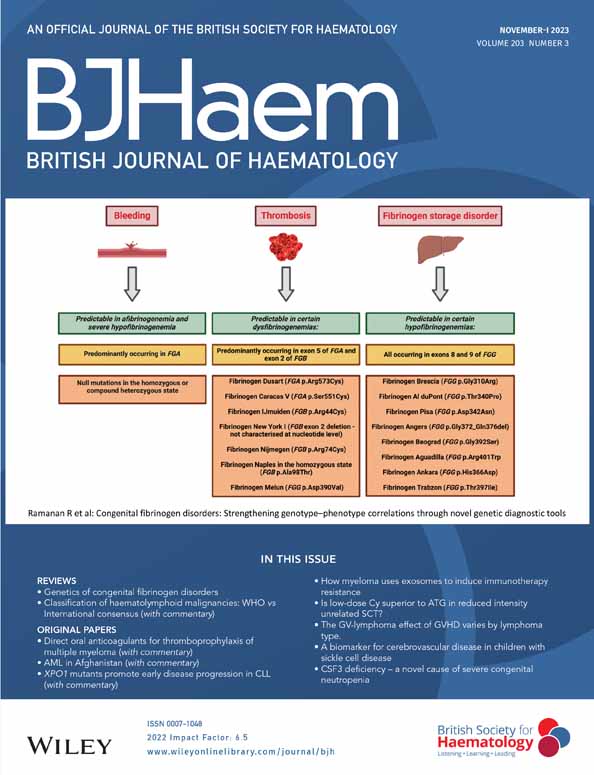Histiocytic neoplasms: Going, going, but not quite gone
Abstract
BRAF and MEK inhibitors have revolutionised the treatment of patients with high-risk histiocytic neoplasms but does a complete response mean that treatment can be withdrawn?
Commentary on: Reiner et al. Outcomes after interruption of targeted therapy in patients with histiocytic neoplasms. Br J Haematol 2023;203:389–394.
In their paper the authors explore the possibility of stopping MAP kinase inhibitor therapy in patients with histiocytic neoplasms.1 These disorders, which include Langerhans cell histiocytosis (LCH), Erdheim Chester disease (ECD) and Rosai Dorfman Destombes (RDD), are myeloid neoplasms caused by mutation in the M-CSF signalling pathway, whose true aetiology was obscured for many years by their bizarre multisystem inflammatory features. The issue of withdrawing targeted therapy is complex in any haematological disease. The first examples of successful strategies may be found in chronic myeloid leukaemia treated with tyrosine kinase inhibitors.2 In other cases, relapse and symptomatic rebound can create significant clinical problems as illustrated by cessation of JAK2 and BTK inhibitors in myeloproliferative neoplasms and CLL, respectively. The goal of achieving treatment-free survival after inhibitor therapy continues to elude patients with high-risk forms of histiocytosis. Several studies have reported high rates of progression in childhood LCH3 and adults with ECD.4 In paediatric LCH, 21/22 patients with high-risk disease progressed within 8 months compared with 5/8 with lower-risk disease.3 The presence of circulating BRAFV600E, the most common driver mutation in LCH, has a strong association with high-risk disease and hence also with lower treatment-free survival. In the LOVE study of ECD, progression was observed in 16/20 at 12 months with a single patient followed up to 24 months without disease recurrence.4 The CRP level was elevated in those who relapsed and may prove useful in monitoring patients off treatment. Even with these high relapse rates, frequent side effects are observed with BRAF and MEK inhibitors in adults with histiocytosis, and an impetus to stop treatment arises in many patients. In the case of CML, it is possible to identify candidates for stopping therapy among those who have received kinase inhibitors for at least 3 years and who are enjoying a stable ‘deep molecular remission’. The concept of molecular remission is harder to apply in histiocytosis, as many studies now show sustained clinical responses in the face of continuing mutation burden.5 This apparently paradoxical result is linked to the propensity of MAP kinase mutations to generate small stable haematopoietic clones of a few percent or less.6, 7 As there is no evident advantage for clones to expand, conversely, there is no pressure for them to disappear on inhibitor therapy, at least for the 5–10 years that these treatments have been used clinically. Fortunately, like CML, which still has a relatively high relapse rate of 50% even when stringent criteria are applied, re-induction is rapid and highly efficacious in nearly all cases. Overall, the chance of achieving treatment-free remission from diagnosis of CML is around 20%.2 As many patients with histiocytosis have single lesions or disease that responds to conventional therapy, it is worth remembering that overall, treatment-free survival is the norm for the vast majority of patients, especially children diagnosed with LCH.
A further 22 adult patients with ECD, LCH, RDD and associated overlap syndromes were included in the current study.1 Molecular aetiology and treatment were more diverse than the previous report on BRAF-mutated ECD. Significantly, only half of the patients made an elective decision to stop treatment; the other half experienced toxicity or financial restraint that limited the duration of their treatment. Progression occurred in a similar proportion of 17/22 cases but was less frequent with prior CR, use of MEK inhibitors and non-BRAFV600E mutations. The majority regained their responses when treatment was resumed. All BRAF-mutated ECD patients eventually relapsed but treatment holidays were quite protracted in some, suggesting that intermittent therapy might be one way to manage side effects and toxicities.
The molecular aetiology of histiocytic neoplasms was only revealed in 2010 with the discovery of BRAFV600E in about two-thirds of LCH cases.8 In just over a decade this discovery has galvanised the field. BRAF and MEK inhibitors, first used to treat ECD patients in 2013,9 have revolutionised therapy for children and adults with previously untreatable diseases.3 The plight of young children ‘trapped’ on inhibitors with unknown long-term consequences and the suffering of all ages, though not infrequent side effects, lend an urgency to further treatment withdrawal studies. While these continue to be challenging, at least there is a high rate of reinduction success; one of the upsides of this fascinating group of disorders.




